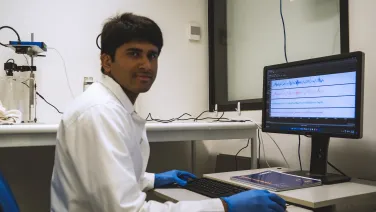
The Kheradpezhouh Group - Calcium Signalling
Our group investigates how calcium channels and receptors affect the sensory processing in cortical neurons with the focus on detection and behaviour.
Research themes
About

The Calcium Signalling Group examines neuronal and non-neuronal Ca2+ signalling on the mammalian brain functions. The Calcium Signalling Group combines in-vivo and ex-vivo optical and electrophysiological recording with genomic manipulation to address how cellular channels and receptors modulates the brain information processing through Calcium. The role of ion channels (transient receptor potential channels, TRP channels), receptors (cholinergic receptors) and transporters (Na+-Ca2+ exchangers) is investigated in the process of Ca2+ signalling. Like the sword of Damocles, abnormal Ca2+ signals kill neurons involving in many brain pathologies including epilepsy, and neurodegenerative disorders such as Alzheimer’s disease and Multiple Sclerosis. By understanding the mechanisms of activation of calcium channels under physiological conditions, our research addresses their role in these pathologies to develop better therapeutics.
Leader Biography
Our group is led by Dr Ehsan Kheradpezhouh. Dr Kheradpezhouh received his PhD in Physiology from the Adelaide University in 2015 investigating the role of calcium channels in paracetamol toxicity with the focus on transient receptor potential channels (TRP channels) in liver cells. Then he pursued his interest in the field of sensory system neuroscience and completed his postdoctoral fellowship at the Neural coding group, Eccles Institute of Neuroscience. Ehsan’s main interest is TRP channels as potential target for neuronal physiology and pathology. His vision is to understand the mechanisms of the activation of calcium channels in physiological conditions and use this knowledge to tackle their roles in neurodegenerative disorders such as Alzheimer’s disease and Multiple Sclerosis as well as epilepsy.
Projects
- Investigating the role of cortical transient receptor potential Ankyrin 1 (TRPA1) in sensory detection and behaviour
- Determining the role of cortical transient receptor potential Ankyrin 1 (TRPA1) in pathogenesis of Multiple Sclerosis
- Investigating the role of cortical transient receptor potential Ankyrin 1 (TRPA1) in pathogenesis of Epilepsy
- Characterising the co-localisation and functional interaction between TRPA1 and TRPV1 in the mammalian cortex and understanding how this interaction affects sensory processing and detection behaviour
- Understanding the role of Muscarinic 1 cholinergic receptor in mouse sensory processing and detection behaviour
- Understanding the role of cortical TRPA1 and TRPV1 in pain sensations
Grants
- National Health and Medical Research Council, Investigator Grant EL1. CI, Kheradpezhouh. Understanding the physiological and pathological roles for Transient Receptor Potential (TRP) channels in the mammalian cortex, APP 2016513 (2024-2028), $630,000. Differed for 1 year (2024-2028).
- National Health and Medical Research Council, Ideas Grant. CIA Kheradpezhouh. The contribution of cortical TRPA1 to sensory perception and behaviour of mammals, APP1181643 (2020-2023), $435,000
- Australian Research Council, Centre of Excellence for Integrative Brain Function, Strategic Initiative Project. CID, Kheradpezhouh. How do predictions affect neural coding in mouse visual and somatosensory cortex? (2021-22), $144,000





